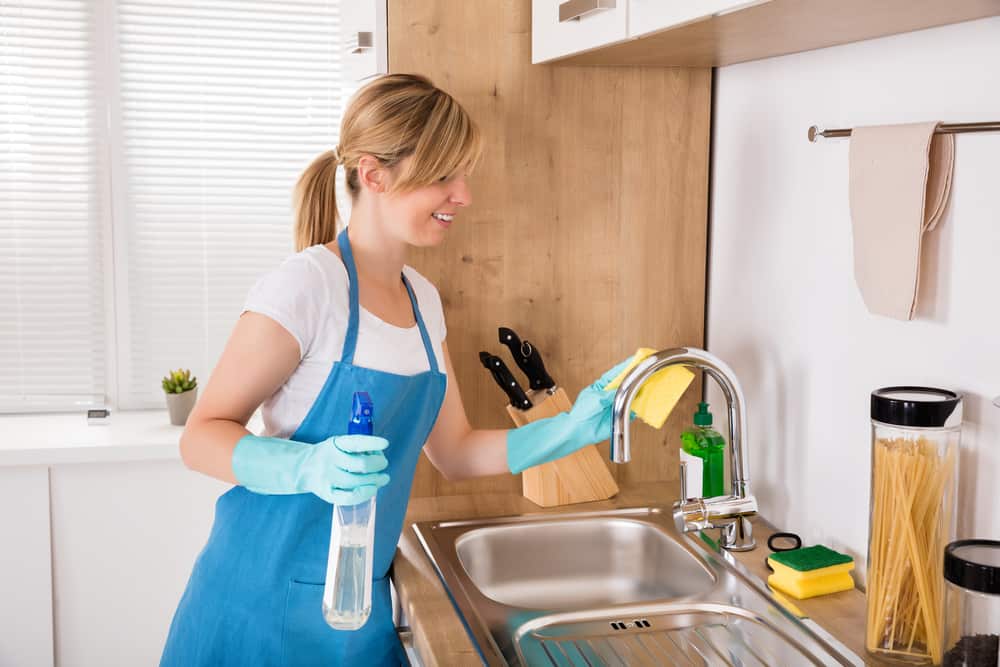The sink is one of the busiest areas in your kitchen. You need it for handwashing, food preparation, pot cleaning and more. Soon, kitchen sink stains begin to appear. Wine, coffee, food splatters and improper rinsing or kitchen sink cleaner are your typical perpetrators. Over time, your sink may also show signs of limescale build-up and rusting.
No worries! Whether you have a stainless steel or porcelain sink at home, there’s always a way to make it sparkling clean again.
How to Remove Kitchen Sink Stains on Stainless Steel and Porcelain
Before you get down to cleaning business, identify your kitchen sink type first. That way, you’ll know how to clean it without damaging the surface. Then make sure that your sink is clear of any rack, mug or food item. Put on your rubber gloves and get ready to clean! Here are the common types of kitchen sinks and the steps you need to wash stubborn kitchen sink stains down the drain.
Stainless steel sink
Stainless steel is durable, stain-resistant and less likely to rust. However, it is prone to surface damage due to acidic food items, abrasive scrubbers and bleach. Also, it is known for showing unpleasant water spots. Follow these steps to keep your sink stain-free and shiny:
- Sprinkle baking soda on your wet stainless-steel sink.
- Dip a soft sponge on hot water then add some dish soap.
- Start scrubbing the sides of the sink then down the basin.
- Push the grime directly into the sink drain.
- Continue wetting the sponge and adding more dish soap as needed.
- Rinse with clean water then wipe dry with a microfibre cloth to prevent water spots.
Remember to never use a wire brush, steel wool or similar scrubbing pads on stainless steel to protect its finish. But, in case of tougher stains or discoloured spots, you may try these cleaning procedures:
- Pour some apple cider or white vinegar on the stained area and let sit for a few minutes. Vinegar has a mild acidic component that can help loosen stains.
- Use a soft cloth for scrubbing. Make sure to follow the grain of the steel.
- Rinse thoroughly then wipe dry with a clean towel.
- If stains are still present, consider using a commercial stainless-steel cleaner or polisher. Follow the instructions on the packaging, rinse the sink, then wipe dry.
White porcelain sink
A white porcelain sink is sturdy and non-porous, but it’s not resistant to stains. Food splatters and water minerals may cause discolouration. This type of kitchen sink is also more susceptible to rusting. And to keep its pearly finish, bleach is its best cleaning agent. Here’s a step-by-step guide to keep it looking new:
- Fill your spray bottle with enough bleach.
- Line your sink with paper towels, then spray it with bleach. This technique will keep the bleach on the sink surface and not slide down the drain.
- Let the bleach work on your kitchen sink stains for about 30 minutes.
- Carefully remove and discard the paper towels.
- Rinse your white porcelain sink then wipe dry.
Vintage and coloured porcelain sink
Bleach can damage these types of sink, so we’ll use hydrogen peroxide instead. Here’s what you need to do:
- Fill your spray bottle with enough hydrogen peroxide.
- Line your sink with paper towels, then spray it with hydrogen peroxide. This technique will keep the solution on the sink surface and not slide down the drain.
- Let the hydrogen peroxide work on your kitchen sink stains for about 30 minutes or more. Hydrogen peroxide is a gentler cleaning agent, so you may need to soak your sink longer to remove stains.
- Carefully remove and discard the paper towels.
- Rinse your vintage or coloured porcelain sink then wipe dry.
You can also use these cleaning agents for all types of porcelain sink to remove stains or rust.
- Use either lemon or vinegar to remove metal stains. Let it sit for at least 5 minutes. When the stain begins to change in colour, rinse the area with water and wipe dry.
- Combine baking soda and some warm water to make a cleaning paste. Rub the mixture on your porcelain kitchen sink with a soft sponge to remove minor scuffs and stains. Rinse thoroughly and wipe dry.
- To remove rust, sprinkle salt on the area then use a lemon half for scrubbing. Wash it with warm soapy water, rinse then wipe dry. Alternatively, you can also replace salt with baking soda then spray with vinegar to make it fizzle. Use a soft sponge to rub the area, rinse it with water then deodorise by rubbing the surface with citrus peel.
Finishing Touches and Upkeep
After cleaning your sink basin, don’t forget to clean your faucet and sink drain as well. Use soapy water with a little vinegar to remove limescale build-up on your faucet. For your sink drain, sprinkle it with baking soda, then pour white vinegar, following a 1:2 ratio. Let it sit for 15 minutes before carefully rinsing with boiling water.
Make it a habit to clean kitchen sink stains. Include these easy how-to steps to your routine and show your kitchen sink some love! And if you’re thinking of doing a complete makeover, check out this article for tips to achieve an expensive-looking kitchen without spending a fortune.


